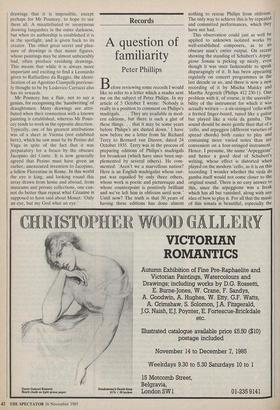Exhibitions
The Achievement of a Connoisseur: Philip Pouncey (Fitzwilliam Museum, Cambridge till 15 December)
Only an eye
David Ekserdjian This country has led the world in the connoisseurship and collection of old mas- ter drawings since the days of the Earl of Arundel and Sir Peter Lely, In this more professional century the grandees and artists may have been replaced by the experts, but a disproportionate number of the best of them remain British. It is no coincidence that so many have worked in museums or the market, as opposed to the universities, and learnt their trade through daily contact with works of art. Philip Pouncey, of the British Museum and Sotheby's, is a supremely distinguished representative of this illustrious tradition. This first Sotheby-Fitzwilliam exhibition is not only the most inspired of 75th birthday presents for him, but also a sheer delight for anyone who loves art and admires scholarship. The 62 drawings on show are a mere selection from the staggering thousand and more discoveries Mr Poun- cey has made over the years, but they are well chosen, so that together they form a memorable and unique monument to the taste and brilliance of one man.
Who is Philip Pouncey, what are his discoveries, and why do they matter? Unlike figures of comparable stature such as Kenneth Clark and E.H. Gombrich, he is unknown to the general public. Even art historians, unless they are interested in Italian drawings, may not have heard of him. The main reason is that he has written comparatively little, although his British Museum catalogues (in collaboration with A. E. Popham and J. A. Gere) are the standard by which such works are judged. By contrast, anyone who has looked at drawings, whether in the greatest of print rooms or the most obscure, will be familiar with the initials PP, and will revere the name of Pouncey.
Print rooms are organised artist by artist, generally on the basis of old inscriptions and time-honoured attributions, but there is invariably also a residue of anonymous drawings, at best grouped by school. Under a given artist are to be found not just autograph drawings, but also works by pupils and followers, copies, and the occa- sional sheet that does not belong. The average specialist should be able to distin- guish between a master and his pupils, or tell an original from a copy, but he may well pass over the odd drawing out in silence. Not so Mr Pouncey, whose two Andrea del Sarto discoveries in this exhibi- tion were previously called Correggio and Federico Zuccaro respectively. The same basic principle operates when it comes to promoting drawings from the ranks of the anonymous, where both the Lotto'and the Correggio on show here were found. Sometimes an article has followed the discovery, but more often a pencil note on the mount initialled PP has been deemed sufficient, and the drawing has been pub- lished — with or without acknowledgment — by someone else.
John Gere, in his exemplary introduc- tion to the catalogue (by Julien Stock and David Scrase — a bargain at £3), sums up the qualities a connoissseur requires and Mr Pouncey so abundantly possesses: 'a visual memory for compositions and details of compositions, exhaustive knowledge of the school or period in question, awareness of all the possible answers, a sense of artistic quality, a capacity for assessing evidence, and a power of empathy with the creative processes of each individual artist and a positive conception of him as an individual artistic personality.' The naming of things has been a favourite occupation since the Garden of Eden, but not every- one believes in attribution. Its critics re- gard it as an academic parlour game played in print rooms that becomes a form of alchemy in the market, where base metal is turned into gold by the simple expedient of changing its name. At best, however, correct additions result in a truer picture of an artist's style, just as the removal of wrongly ascribed works clarifies the out- line. More importantly, there are so many drawings that it is impossible, except perhaps for Mr Pouncey, to hope to see them all. A misattributed or anonymous drawing languishes in the outer darkness, but when its authorship is established it is in the spotlight, and is given back to its creator. The other great secret and plea- sure of drawings is that minor figures, whose paintings may be almost unbearably bad, often produce ravishing drawings. This means that while it is always more important and exciting to find a Leonardo given to Raffaellino da Reggio, the identi- fication of an Agostino Ciampelli previous- ly thought to be by Lodovico Carracci also has its rewards.
Mr Pouncey has a flair, not to say a genius, for recognising the 'handwriting' of draughtsmen. Many drawings are attri- buted when their connection with a known painting is established, whereas Mr Poun- cey tends to work in the opposite direction. Typically, one of his greatest attributions was of a sheet in Vienna (not exhibited here), which he saw must be by Perino del Vaga in spite of the fact that it was preparatory for a fresco by the obscure Jacopino del Conte. It is now generally agreed that Perino must have given an earlier, unexecuted invention to Jacopino, a fellow Florentine in Rome. In this world the eye is king, and looking round this array drawn from home and abroad, from museums and private collections, one can- not do better than repeat what azanne is supposed to have said about Monet: 'Only an eye, but my God what an eye.'



































































 Previous page
Previous page